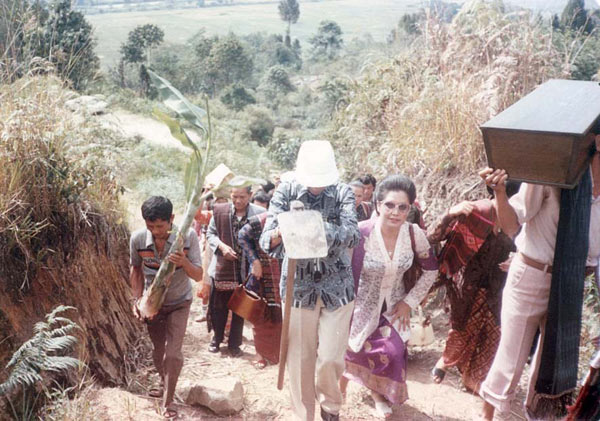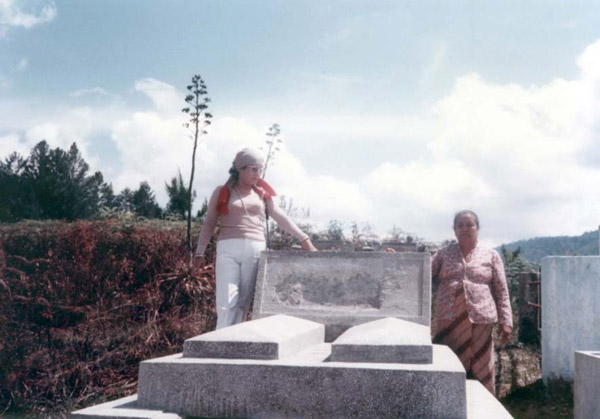
|
| home | site map | bibliographies | country | forum | links | studies | what's new | photogalleries | about us | |
|
 |
||
|
these images
are © and may not be reproduced without the express permission of Pamela
A Cross and Vera Tobing |
click on main photo enlargement to go to Vera Tobing collection photogallery - click on any thumbnails to go to further photo enlargements |
The wife of Jakobus L. Tobing and mother of Theodorik L. Tobing was known in her family as 'Nai Horja'. She was a br. Hutagalung from Huta Harean and her Christian name is thought to be Maria. Her great-grandaughter, Maria DRT Ambesa has been told the story of how, when her mother, Vera, was due to give birth to her fourth child, Vera's grandparents, Theodorik and Ernestina, come to stay at her home in Medan because of their love and concern for her. They were particularly worried against a background of the tense situation (and curfew) in Indonesia during the 1965/66 communist massacres and handover in power from Sukarno to Soeharto. On 16 August, 1966 Vera had a safe delivery and, as the story goes, her relieved and happy grandfather named the baby girl Maria after his mother.
The bones of Maria br. Hutagalung, known in the family as "Nai Horja", the wife of Jakobus L. Tobing and mother of Theodorik L. Tobing, have been dug up from her initial grave in Pematang Siantar, cleaned and wrapped in a sibolang (similar to the one shown in the Vera Tobing collection). The wrapped bones are then placed carefully in a casket for transportation and reburial next to her husband in the Silindung valley in Sirau-rau, outside the town of Tarutung on the way to Sibolga. When her husband, Jakobus, died she left the Silindung valley to live with her (second) son, Theodorik and his family in Pematang Siantar where he was employed as Manteri Blasting (Head Tax Collector) of the Simalungun district for the Netherlands government. Her eldest son had died before Theodorik was married. Nai Horja may well have left the Silindung valley to live with her son to avoid the Batak custom of a widow being married to one of his surviving brothers.
Close up of Oloan, granddaughter and eldest boru, being assisted by her nephew Simon (younger brother of Vera Tobing), to lift up the casket holding the bones before she carries it up the hill for the reburial. Oloan is the daughter (and third child) of Theodorik L. Tobing, the second son of Jakobus and Nai Horja. Oloan is wearing the sadum woven by Theodorik's wife, Ernestina br. Hutagalung (see photo of Ernestina below) which is part of the Vera Tobing collection. Simon, is the eldest son of Tahi Samurung, the eldest son of Theodorik and Ernestina. He has a ragi hotang over his shoulder and there is another folden ragi hotang lying over the casket. These are similar to the ones shown in the Vera Tobing collection.
Oloan carrying the casket containing Nai Horja's bones up the hill for reburial. She is the daughter (and third child) of Theodorik L. Tobing, the second son of Jakobus and Nai Horja. Oloan is wearing the sadum woven by Theodorik's wife, Ernestina br. Hutagalung (see photo of Ernestina below) which is part of the Vera Tobing collection. Vera, eldest granddaughter of Theodorik and niece of Oloan, is shown standing to the left of the picture.

The climb up the steep hill to the grave. From left to right in the front of the camera: Timbul Hutabarat, a driver for the family. He is carrying a banana tree to be planted on the grave to drive away any other spirits which might be around the grave; Mr. Hutagalung, Oloan's father-in-law, who is carrying a pick-axe; Vera Tobing; Mr Hutagalung's son and Oloan's husband, Jan Piter Hutagalung, carrying the casket perhaps because Oloan was tired. He is wearing over his shoulder one of the blue Toba Batak ulos (sibolang, bolean, surisuri) so important for traditional ceremonies. Note how several people are wearing traditional ulos.
A frail looking Ernestina br. Hutagalung, widow of Theodorik L. Tobing, on the day of celebration after the reburial of the bones of her mother-in-law, Nai Horja. Both Nai Horja (Maria br. Hutagalung) and Ernestina were originally from the same village, Huta Harean, the origin of the marga Hutagalung. The reburial was regarded as a happy not a sad time. At the time of this photo in July 1982 Ernestina was 89. She is wearing, as befits a grandmother and great-grandmother, a ragidup in the style of those woven in the Silindung valley. The ragidup is very similar in style to the one in which she was wrapped in her own coffin two and a half years later in January 1985.

The tomb of Jakobus L. Tobing and his wife in the Silindung valley in Sirau-rau, outside the town of Tarutung on the way to Sibolga. When built it was designed to receive both Jakobus and his wife. Their great grandaughter, Vera, is shown standing on the edge of the tomb with her mother, Tianur br. Hutabarat to the right of the photo. Tianur was the wife of Tahi Sumurung L. Tobing, the eldest grandson of Jakobus. Vera is the eldest child of Tianur and Tahi.
The photos of the reburial (and also Ernestina's later funeral) were shown to Batak expert, Sandra A. Niessen and she commented in a personal communication: "I'm fascinated by the comment about the happy funeral. This is very
well-known. Everybody knows that if you are saur matua or sarimatua you have
a "happy" funeral because you have achieved the highest that life offers.
But still they mangandung (sing ritual songs that are almost inevitably sad,
with tears in the voice ...) because the
moment of separation is always sad -- regardless of whether you are told
that this is a "Happy" funeral. And bone reburial: the same thing applies.
It is a superb moment for the clan. They have to get money from all the
members because it isn't cheap!!! Building the mausoleum is very expensive.
And then hiring the Batak orchestra is also very expensive. And clan members
come from far and wide and they have to bring rice and money and spend days
of their precious time. The bones are dug up -- very exciting when the bones
are found in the ground. And then the elderly pull the sirih quids out of
their mouths, and start painting the bones red with the quid, washing them,
cleaning them, and place them in the mini-coffins (bone boxes) in which they
are carried to the mausoleum. Every clan tries to outdo every other clan in
the size and special nature of their mausoleum. The homes for the bones are
usually much nicer than the homes for the living. So it is the moment when
the clan "shines" -- their turn to do reburial. Everybody in the vicinity
knows which clan is doing their reburial ceremony. And the music can be
heard far and wide. Usually the bones of many people are re-buried during
the same ritual. But there is also sadness when the bones are dug up.
Memories, tears."
ulos in the Vera Tobing collection
photographed by Mari Pro Foto Studio, Jawa Barat Depok |
click
on main photo enlargement to go to Vera Tobing collection photogallery
- click on any thumbnails to go to further photo enlargements
|
Both Pamela and Maria are very grateful indeed for the encouragement and advice which they have received from Sandra Niessen, a leading expert on the Batak and their textiles. See an autobiography and Batak references for more information about Sandra and her publications.
|
| home
|
site map | bibliographies
| country | forum |
links | studies
|
what's new
| photogalleries | about
us | |
|
Copyright © 2012 Pamela A Cross. The contents of this site, including all images and text, are for personal, educational, non-commercial use only and may not be reproduced in any form without the express permission of Pamela A Cross. |
|
If
you have any comments
on the tribaltextiles.info website please send them to us. If you have
any general tribal textile comments or questions go to the tribaltextiles.info/community
forum to share your thoughts and questions with an international
community of enthusiasts. |
this
page last updated
22 April, 2009
|